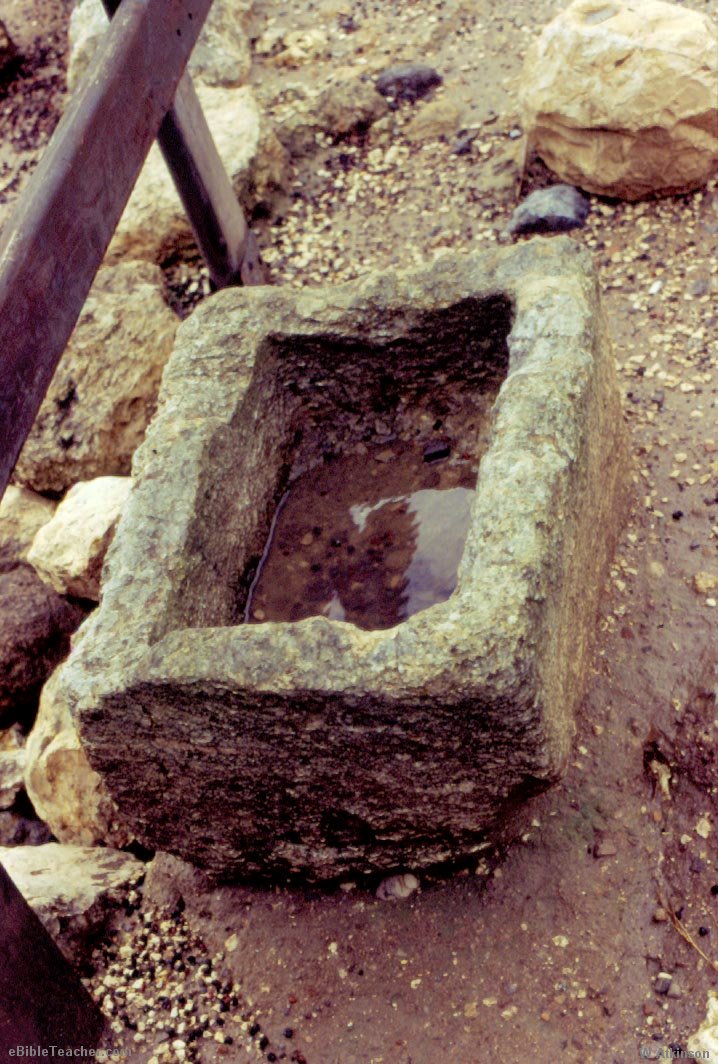And she brought forth her firstborn son, and wrapped Him up in swaddling clothes, and laid Him in a manger; because there was no room for them in the lodgings.Many people usually think that the Christ child was placed inside a manger because it resembled a cradle. While this may be true to an extent, newborn babies don't really need a crib yet as they could not move much. Even in our time, we only transfer babies from bassinets into infant beds when they are three or four months of age (as they could tip themselves out). Mary could have chosen to place the child beside her, but instead she chose a feeding-trough for her Child.
-Luke 2:7
 One thing we need to see is that the Infant was placed in a feeding trough for animals (see, for example, the illustration at left depicting a stone manger from Israel, which would have been similar to the one in which Jesus was laid on).
One thing we need to see is that the Infant was placed in a feeding trough for animals (see, for example, the illustration at left depicting a stone manger from Israel, which would have been similar to the one in which Jesus was laid on).Early iconographers seem to be aware of a sort of connection between the Nativity and the Eucharist (John 6:51-58), as in many of these representations the animals push their muzzles into the manger as if to eat from it (or nibbling at the Child's hand). The manger itself was depicted as something similar to a bread-basket or even as a raised structure somewhat similar to an Altar. In fact, in some of the above depictions architectural elements block the view of and segregate the beasts, shepherds and angels from the inner sanctum like a rood screen, who are looking on the Infant in quiet reverence like worshippers in a medieval Church.
In these images Christ is presented not as the cute baby of our Christmas cards but as the spotless Lamb of God destined for a sacrifice on the cross that will be revisited in the Eucharist. El Greco makes the emphasis on sacrifice rather explicit in his depiction of the Adoration of the Shepherds where the inclusion of a trussed lamb identifies the child as the sacrificial Lamb "who will take away the sins of the world."
 In Eastern iconography, there came a type of image depicting the infant Christ either lying on the altar or within a paten covered by the asterisk, with his midsection covered by a liturgical cloth (see left portion of the icon at right). This was known as the melismos ("breaking"), with the name coming from the action of breaking the consecrated bread, known as Amnos in Greek or Amnets in Slavonic, both meaning "Lamb", with a scalpel called a "spear" (in reference to the spear that pierced the side of Jesus; John 19:33-37) that the priest performs just before distributing Holy Communion.
In Eastern iconography, there came a type of image depicting the infant Christ either lying on the altar or within a paten covered by the asterisk, with his midsection covered by a liturgical cloth (see left portion of the icon at right). This was known as the melismos ("breaking"), with the name coming from the action of breaking the consecrated bread, known as Amnos in Greek or Amnets in Slavonic, both meaning "Lamb", with a scalpel called a "spear" (in reference to the spear that pierced the side of Jesus; John 19:33-37) that the priest performs just before distributing Holy Communion."Broken and distributed is the Lamb of God; broken yet not divided, ever eaten yet is never consumed, but sanctifies those who partake of Him."The diskos itself (which answers to the paten of the Western Church), on which the Lamb is laid, is taken to be representative either of the manger or Mary, who bore Christ in her womb, and at the same time, the tomb on which Jesus was laid. The asteriskos meanwhile represents the star of Bethlehem (Matthew 2:9 is even quoted as the asteriskos is placed over the Lamb before the start of the Divine Liturgy), while the veil called aër (vózdukh), which covers both the diskos and the chalice, represents both the swaddling-clothes and the shroud which covered the Lord during burial.
The connection between the manger and the cross is also evident in another element of Eastern icons of the Nativity: in it the infant Jesus is bound, mummy-like, by strips of cloth (which is similar to the depiction of the Lord's grave clothes in burial) and rests in a raised structure, which in addition to its (vague) resemblance to an altar, also looks like a stone coffin.
The final connection between the Eucharist and Christmas we can make is the name of Bethlehem itself. Beit Lehem (בית לחם) is Hebrew for "House of Bread" (the Arabic name بيت لحم Bayt Laḥm is also interesting, as it literally means "House of Lamb" or "House of Meat"!); how fitting it is that the One who said He was the bread of life (John 6:35) was born in the House of Bread!

No comments:
Post a Comment